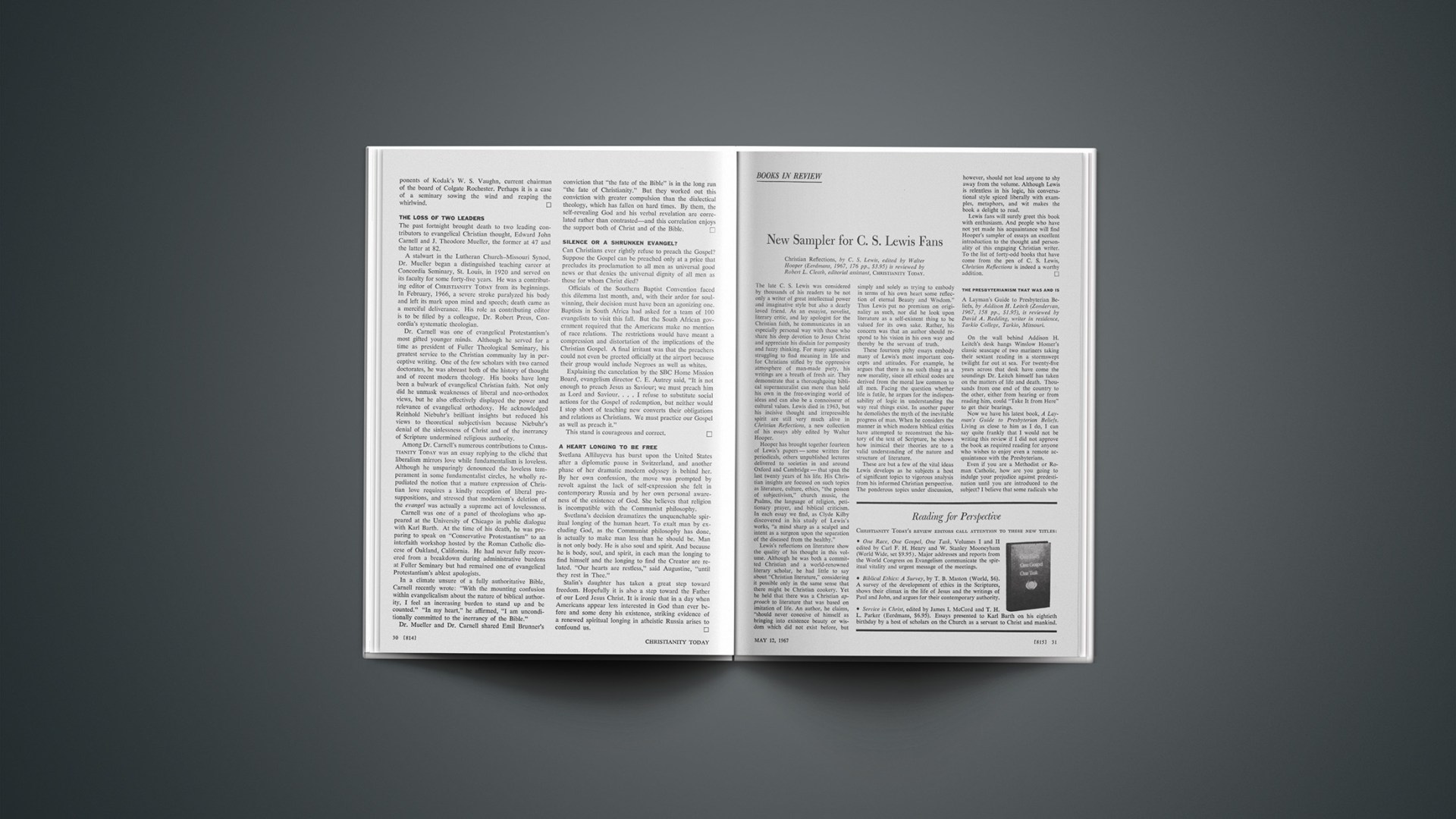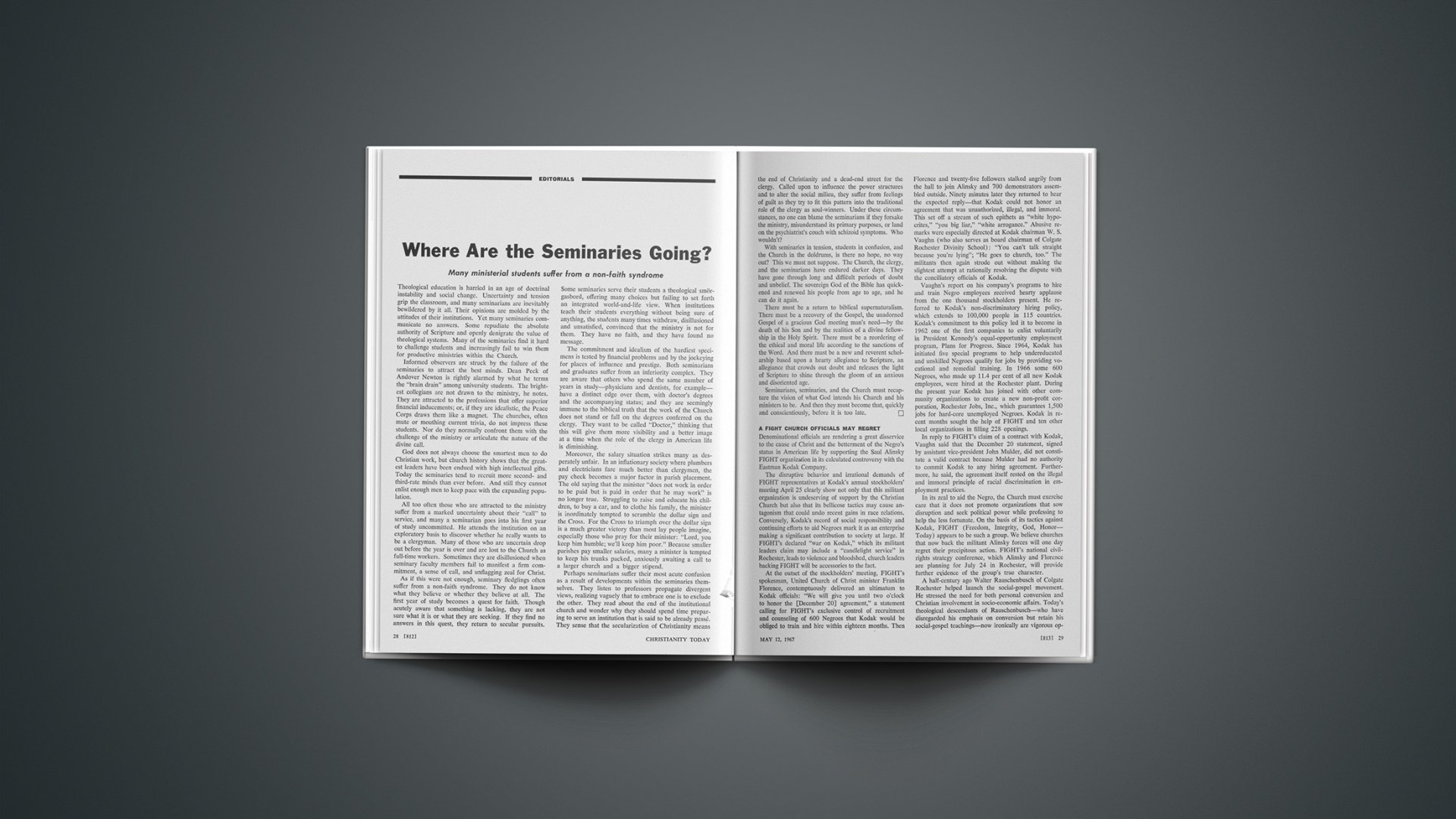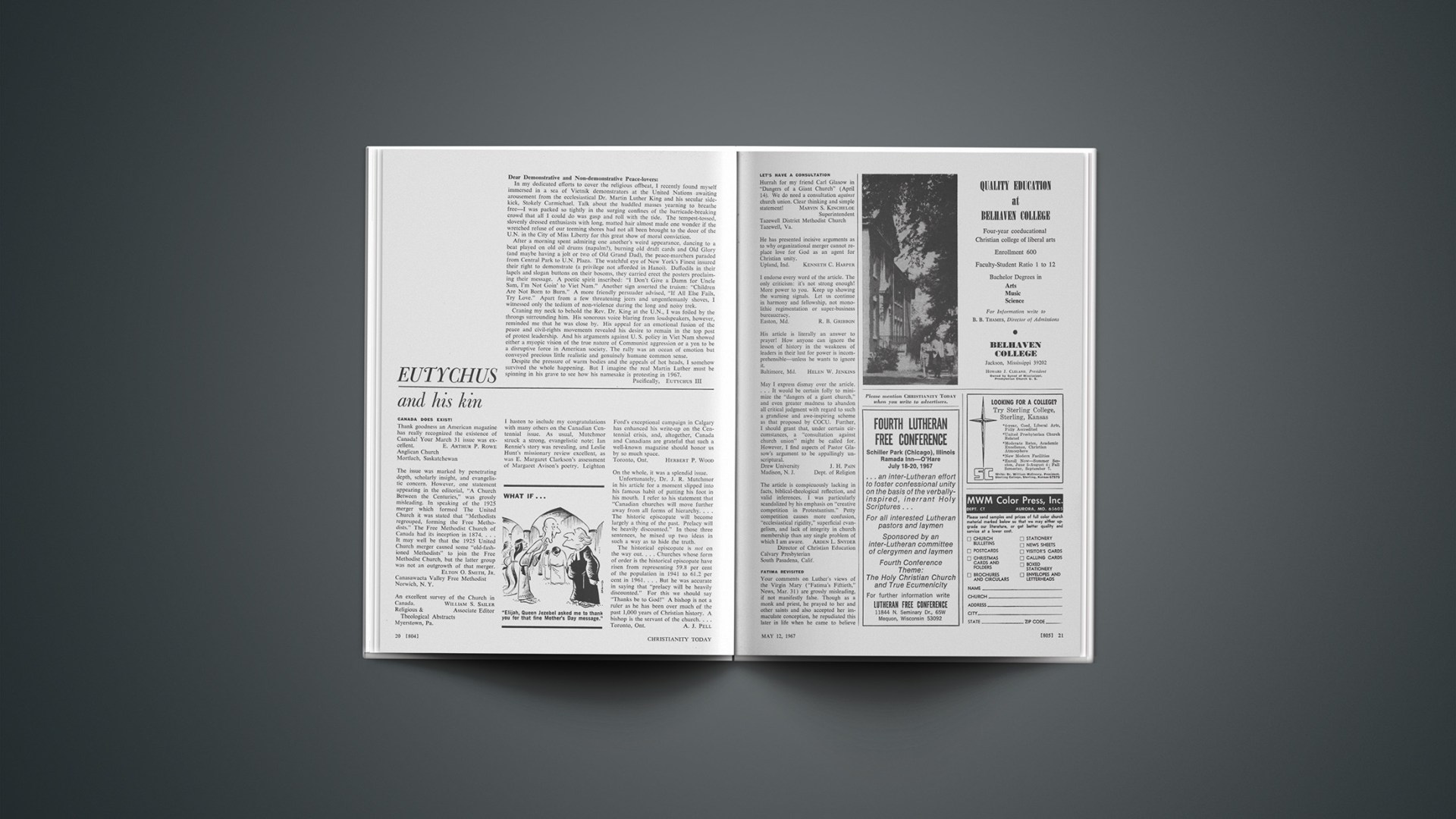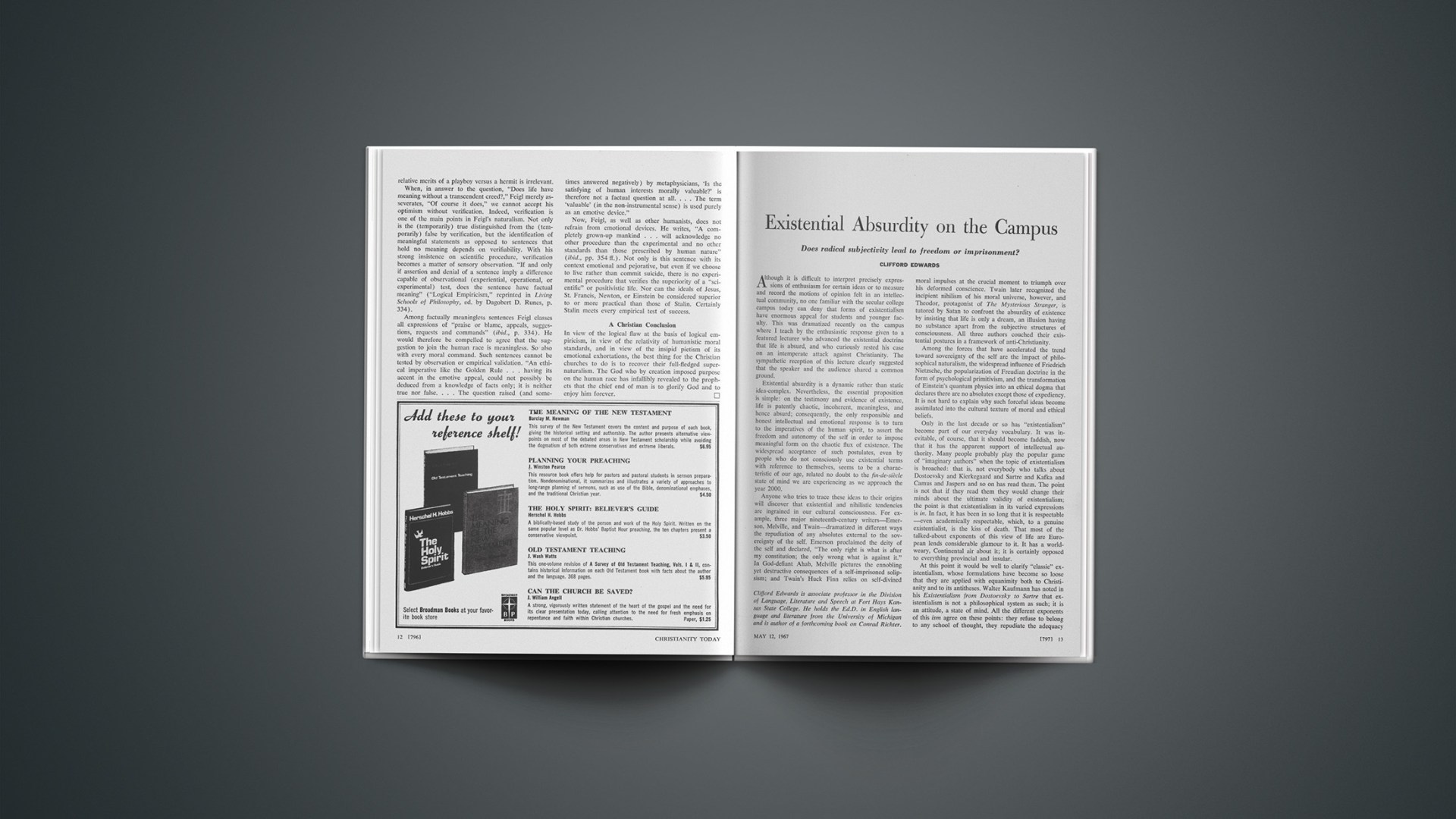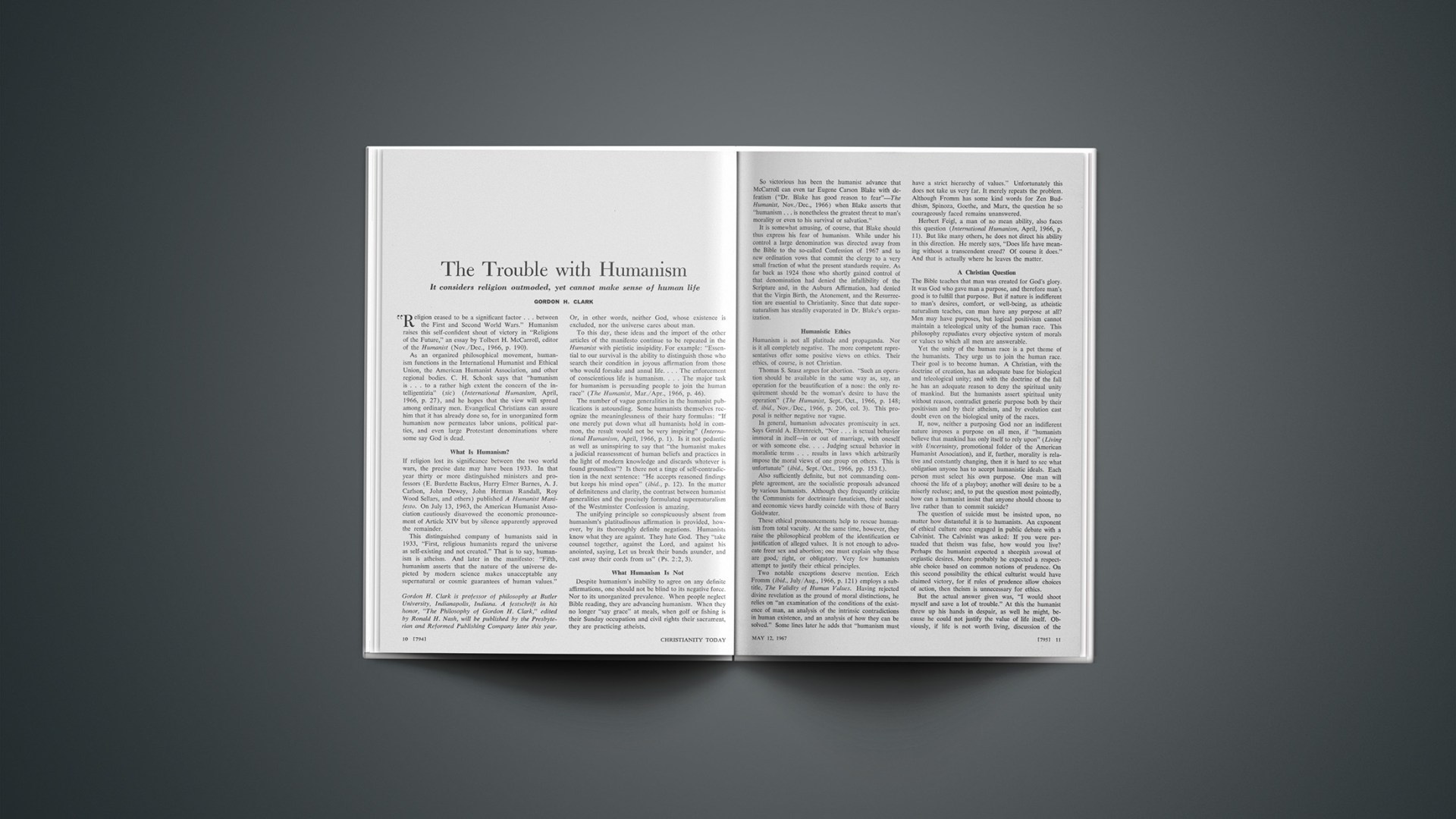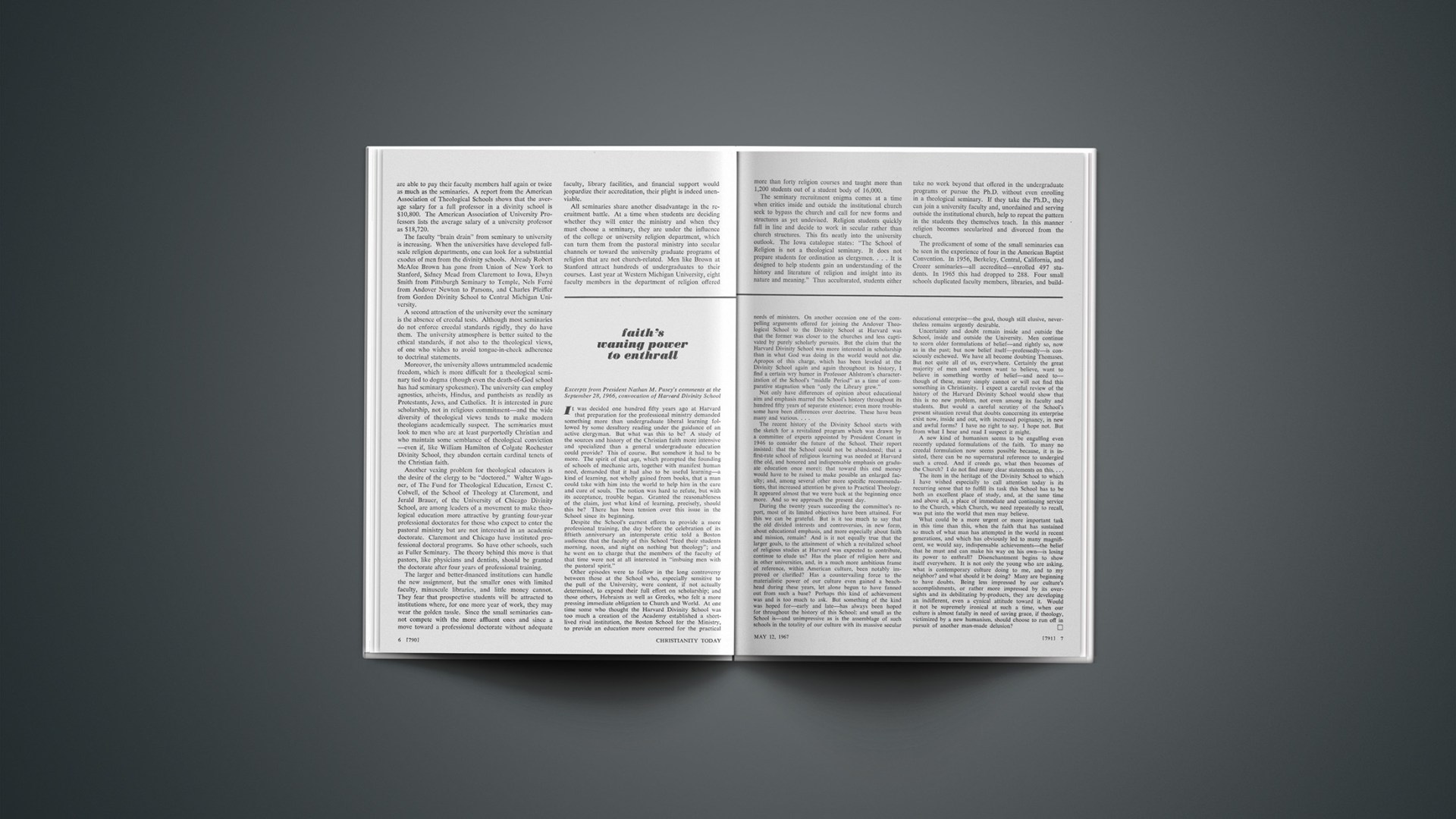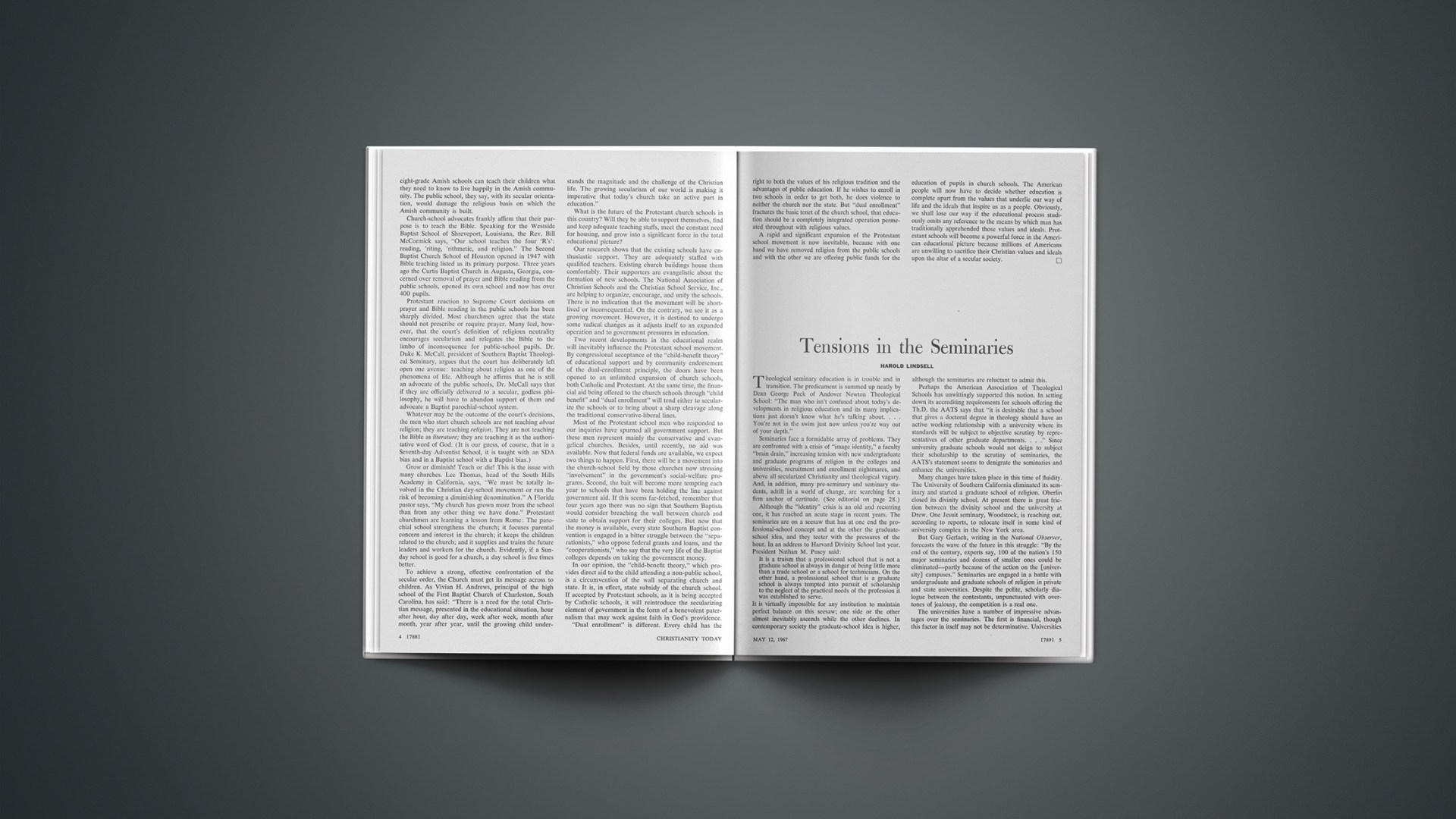New Sampler For C. S. Lewis Fans
Christian Reflections, by C. S. Lewis, edited by Walter Hooper (Eerdmans, 1967, 176 pp., $3.95) is reviewed by Robert L. Cleath, editorial assistant,CHRISTIANITY TODAY.
The late C. S. Lewis was considered by thousands of his readers to be not only a writer of great intellectual power and imaginative style but also a dearly loved friend. As an essayist, novelist, literary critic, and lay apologist for the Christian faith, he communicates in an especially personal way with those who share his deep devotion to Jesus Christ and appreciate his disdain for pomposity and fuzzy thinking. For many agnostics struggling to find meaning in life and for Christians stifled by the oppressive atmosphere of man-made piety, his writings are a breath of fresh air. They demonstrate that a thoroughgoing biblical supernaturalist can more than hold his own in the free-swinging world of ideas and can also be a connoisseur of cultural values. Lewis died in 1963, but his incisive thought and irrepressible spirit are still very much alive in Christian Reflections, a new collection of his essays ably edited by Walter Hooper.
Hooper has brought together fourteen of Lewis’s papers—some written for periodicals, others unpublished lectures delivered to societies in and around Oxford and Cambridge—that span the last twenty years of his life. His Christian insights are focused on such topics as literature, culture, ethics, “the poison of subjectivism,” church music, the Psalms, the language of religion, petitionary prayer, and biblical criticism. In each essay we find, as Clyde Kilby discovered in his study of Lewis’s works, “a mind sharp as a scalpel and intent as a surgeon upon the separation of the diseased from the healthy.”
Lewis’s reflections on literature show the quality of his thought in this volume. Although he was both a committed Christian and a world-renowned literary scholar, he had little to say about “Christian literature,” considering it possible only in the same sense that there might be Christian cookery. Yet he held that there was a Christian approach to literature that was based on imitation of life. An author, he claims, “should never conceive of himself as bringing into existence beauty or wisdom which did not exist before, but simply and solely as trying to embody in terms of his own heart some reflection of eternal Beauty and Wisdom.” Thus Lewis put no premium on originality as such, nor did he look upon literature as a self-existent thing to be valued for its own sake. Rather, his concern was that an author should respond to his vision in his own way and thereby be the servant of truth.
These fourteen pithy essays embody many of Lewis’s most important concepts and attitudes. For example, he argues that there is no such thing as a new morality, since all ethical codes are derived from the moral law common to all men. Facing the question whether life is futile, he argues for the indispensability of logic in understanding the way real things exist. In another paper he demolishes the myth of the inevitable progress of man. When he considers the manner in which modern biblical critics have attempted to reconstruct the history of the text of Scripture, he shows how inimical their theories are to a valid understanding of the nature and structure of literature.
These are but a few of the vital ideas Lewis develops as he subjects a host of significant topics to vigorous analysis from his informed Christian perspective. The ponderous topics under discussion, however, should not lead anyone to shy away from the volume. Although Lewis is relentless in his logic, his conversational style spiced liberally with examples, metaphors, and wit makes the book a delight to read.
Lewis fans will surely greet this book with enthusiasm. And people who have not yet made his acquaintance will find Hooper’s sampler of essays an excellent introduction to the thought and personality of this engaging Christian writer. To the list of forty-odd books that have come from the pen of C. S. Lewis, Christian Reflections is indeed a worthy addition.
Reading for Perspective
CHRISTIANITY TODAY’S REVIEW EDITORS CALL ATTENTION TO THESE NEW TITLES:
• One Race, One Gospel, One Task, Volumes I and II edited by Carl F. H. Henry and W. Stanley Mooneyham (World Wide, set $9.95). Major addresses and reports from the World Congress on Evangelism communicate the spiritual vitality and urgent message of the meetings.
• Biblical Ethics: A Survey, by T. B. Maston (World, $6). A survey of the development of ethics in the Scriptures, shows their climax in the life of Jesus and the writings of Paul and John, and argues for their contemporary authority.
• Service in Christ, edited by James I. McCord and T. H. L. Parker (Eerdmans, $6.95). Essays presented to Karl Barth on his eightieth birthday by a host of scholars on the Church as a servant to Christ and mankind.
The Presbyterianism That Was And Is
A Layman’s Guide to Presbyterian Beliefs, by Addison H. Leitch (Zondervan, 1967, 158 pp., $1.95), is reviewed by David A. Redding, writer in residence, Tarkio College, Tarkio, Missouri.
On the wall behind Addison H. Leitch’s desk hangs Winslow Homer’s classic seascape of two mariners taking their sextant reading in a stormswept twilight far out at sea. For twenty-five years across that desk have come the soundings Dr. Leitch himself has taken on the matters of life and death. Thousands from one end of the country to the other, either from hearing or from reading him, could “Take It from Here” to get their bearings.
Now we have his latest book, A Layman’s Guide to Presbyterian Beliefs. Living as close to him as I do, I can say quite frankly that I would not be writing this review if I did not approve the book as required reading for anyone who wishes to enjoy even a remote acquaintance with the Presbyterians.
Even if you are a Methodist or Roman Catholic, how are you going to indulge your prejudice against predestination until you are introduced to the subject? I believe that some radicals who will turn to this book to find out what Presbyterianism was may be stirred into accepting what it still is.
The chapter headings recall the stays by which reformed faith has been supported since Calvin incorporated it from Paul and Augustine. The volume begins by uncovering an almost forgotten main stay, “The Sovereignty of God,” and doesn’t rest till it reaches “Social Action.” And who could be better qualified to speak about “The Faith Once and For All Delivered” than a former Presbyterian seminary president and professor who did his Ph.D. thesis on The Relevancy of John Calvin to Modern Protestantism?
Here is no heavy tome but a paperback as hard to put down as others on the newsstand. Civil rights, we find, are just catching up to “The Holy Scriptures” instead of the Scriptures to them. And Leitch writes fearlessly on this moot subject: “One of the strangest facts about Calvinism and its descent through the reformed tradition is that where it is most Calvinistic, that is, where it is truest to its emphasis on the absolute sovereignty of God, there it most surely releases the free energies of man.” Neither our emphasis on social action nor our superiority in science embarrasses the Word of God. Leitch quotes Kepler: “The Bible is not written to describe how the heavens go but how to go to heaven.”
It is fun to read a book written by a “comprehensive man” instead of a bookworm. This author is a happy combination of athlete and poet, as likely to quote Milton as to call a football play to sneak his points past our guard. He brings Stan Musial up to bat to explain predestination. God knows Stan had free choice. Then how could we anticipate his batting average year after year with such accuracy? Leitch does not parade erudition. He not only speaks our language but also has the uncommon courtesy to make himself clear.
Our author is not unaware of how irrelevant the Church has so often been; but rather than joining the literary mob as they alternately wring their hands and throw stones, he tries to do something about the problem. The materialist never tires of telling us that all we are hearing when we hear a violin is “the scraping of the hair of a horse over the stomach of a sheep”; but Leitch believes that it can make music, and so he makes many old definitions sing again with pertinence. Here is how he brings a sacrament up into the twentieth century:
A young man going into the military was offered a blank check or any other gift by his father. The father wanted so much to go with the son and support him in any way he could. The father had a habit of twirling a pocket knife on the end of his watch chain and interestingly enough, the boy asked for that knife. Wherever he went after that he carried his father’s knife, and in time of fear, or loneliness, or temptation he could take out the knife and manipulate it as his father habitually did; and all the good things of his family would come flooding in to support him [pp. 114, 115].
My impression as I read the book was not that it was about dated beliefs on their way out; rather, it is about beliefs that are coming back—and with a blessing, not with a vengeance. “God is dead” grabs today’s headlines, but after the “God stuffers” who have temporarily turned theology into taxidermy have had their day, the large words that Addison H. Leitch has restated so well will continue to stand out, urging men to “Stay On and Be Stayed.”
A Call For Revolution
Man in Community, edited by Egbert de Vries (Association, 1966, 382 pp., $5.75), is reviewed by C. Gregg Singer, chairman, Department of History, Catawba College, Salisbury, North Carolina.
The last volume in the series of four prepared for the Geneva Conference on Church and Society of the World Council of Churches is the most pointed and dangerous of them all. It brings together and enlarges upon the basic presuppositions set forth in the first three and draws some other conclusions. What emerges in these pages is truly frightening for both the evangelical Christian and the patriotic American. It reveals with startling clarity the basic cleavage between the liberalism of the World Council and evangelical orthodoxy. The theological liberalism of the four volumes in this series is here presented as the rationale for radical social, economic, and political action that the World Council is reflecting to its constituent members as the basis for a social revolution in their countries.
The opening chapter sets the stage. Its basic assumption is that philosophy has the right to develop new norms to deal with new social and economic situations. The days are gone when social rules and structures were to be regarded as having come to man by divine revelation. Modernity makes freedom possible, but the same modernity has also done away with the sacred (sacral) approaches to social, economic, and political issues. Theology has nothing to say to philosophy or to social and economic thought.
The next chapter frankly abandons the biblical ethic in favor of a situational approach. This approach is used to scrutinize marriage and the family. According to this, the Bible does not set forth a special doctrine of the family; it simply accepts the natural order in the family relationship. The book admits that modern sociology and other secular disciplines hold that the traditional concept of the family is not flexible enough to meet modem needs and should therefore give way to other forms of social organization. The author of this chapter then raises the question: What form of the family does God want? His answer is that God wants that form of the family which best equips people to meet the demands of modern society and which most helps them become persons.
The last section of this book deals with the general idea of advancing toward a secularized society. Because the Church as it exists today hinders the formation of wholesome personalities, it must aid in the creation of a secularized society. This secularization brings with it a state of human relations free from domination by any religion or ideology. The Church is to be used for the destruction of Western culture and the elimination of the last vestiges of a Christian society.
Obviously, this volume contains a lot of doubletalk. There can be little doubt that it is a basic repudiation of evangelical doctrine and presents a thinly disguised call for social and economic revolutions of a kind quite contrary to the biblical message.
How A Preacher Is Tempted
A Preacher’s Temptations, by James H. Blackmore (Edwards and Broughton, 1966, 120 pp., $4) and The Anatomy of the Ministry, by Gene E. Moffatt (Pendulum, 1966, 287 pp., $2.95), are reviewed by Richard P. Buchman, minister, The Cadman Memorial Church (Congregational), Brooklyn, New York.
The preacher can be forgiven his joy on those all too rare occasions when a young man tells him he has decided to become a minister. But he must bear part of the burden of guilt if that same young man, some years later, gives it up as a bad job and storms out of the pulpit disillusioned, bitter, and perhaps ruined. Here are two helpful books, written by men who have served in the pastorate and have uncovered just about all the things that can happen to the Lord’s faithful servants—and then some.
James H. Blackmore, director of public relations at Southeastern Baptist Theological Seminary, lists forty temptations common to the clergy and does so with grace, humor, and commendable brevity. It seems downright unfair that the devil has at least forty ways to seduce us; but Blackmore takes the enemy seriously, and his words hit home. For instance, his discussion of the temptation “to think it all depends on us” is timely in this day when many a minister foresees the death of the Christian Church in a generation unless he does this or that right now. This, Blackmore points out, was Elijah’s sin at Horeb when he seriously underestimated the size of the Remnant. The author’s illustrations, scriptural and otherwise, are profuse and nearly always to the point. The book should be read before, during and after seminary, so long as the reader remembers that the Lord is able to pick up his fallen servants and make good use of them.
The Anatomy of the Ministry is a comprehensive attempt to deal with such questions as “just how and why a man becomes a minister, just what he is supposed to do, how well he should do it, and how well he does do it.” Drawing on the personal experiences of ministers and a wealth of statistics, Moffatt discusses the call, theological training, the demands of different pastorates, the problems common to all pastorates, financial realities, the role of the minister’s wife, and the ever-present temptations. In a chapter entitled “How the Mighty Are Fallen,” the author describes in frank and earthy terms the minister’s constant difficulties with that Old Debbil, Woman—his own and others. I knew we ministers were normal, but according to Moffatt, we’re unbelievable! Altogether his volume is a remarkable, fact-filled survey of the world’s grandest profession written by a man who knows it well and still loves it.
Japan’S New Religions
The Rush Hour of the Gods: A Study of New Religious Movements in Japan, by H. Neill McFarland (Macmillan, 1967, 267 pp., $5.95), is reviewed by Gordon K. Chapman, veteran missionary, Tokyo, Japan.
The professor of history of religions at Perkins School of Theology has provided students of post-war religious developments in Japan with a perspicacious treatment of the so-called new religions. Although several treatises on this subject have already been published in English, this book is the first major effort by a competent scholar to interpret the new movements as a significant socio-religious phenomenon. And, though it is not within his avowed purpose, the author also suggests some of the reasons why these new indigenous cults, rather than Christian churches, have experienced rapid growth in the post-war religious vacuum.
McFarland is chiefly concerned with tracing the historical and cultural roots of these indigenous new religions and evaluating their actual or potential function in meeting the needs of frustrated souls in a technological society that is rapidly becoming urbanized. Although the Japanese have a reputation for religious indifference, evidence the author presents suggests that, at least in those affiliated with the five principal religions, the incidence of interest and active participation is rather high.
This is not to say that these new faiths are fully adequate for the needs of the present situation. They are too deeply rooted in the traditional folk religion of shamanism and ancestor worship and are irresponsibly eclectic and superficial in their approach to human needs. Often they provide a channel for religious escapism.
We must fully recognize, however, that these mushrooming cults are a challenge to the Christian forces to reexamine their method of carrying out the mission of the Church in Japan. In accordance with the peculiar genius of the Japanese people, the new religions have doctrinal teaching that is empirical and pragmatic rather than metaphysical or abstruse and is adapted to the intelligence of the average man. They present certain concrete goals that contribute to the physical, aesthetic, economic, and social well-being of their adherents. And they offer people an opportunity to be identified with a powerful and successful community that provides both the procedures of group dynamics and the processes of group therapy. Believers are encouraged to practice some form of self-expression and to engage in purposeful activity involving sacrifice, such as manual labor, acts of mercy and personal witness, and giving to costly building enterprises. Under charismatic leadership, laymen are urged to labor for the ideal of an earthly paradise of happiness and peace.
This excellent book is highly recommended to all who have on their hearts the evangelization of Japan.
Who Counsels The Counselor?
Person and Counselor: Responsive Counseling in the Christian Context, by Paul E. Johnson (Abingdon, 1967, 208 pp., $4.50), is reviewed by Gordon Stanley, visiting lecturer in psychology, Indiana University, Bloomington, Indiana.
Pastoral counseling is a practical discipline that has emerged from the continuing dialogue between psychology and theology. This book, the author says, “is concerned with the dedication and preparation of the pastoral counselor.”
In his theoretical interpretation of counseling, Johnson speaks of the “psycho-theological ground of community,” a notion based on Buber’s I-thou theology of relationship. Johnson draws a close analogy between Christ’s role as mediator between sinful man and God, and the pastoral counselor’s role as a mediator between anxious man and other men. Naturally, this is a dangerous analogy, and Johnson rightly asks: “How can the pastoral counselor be this great?” This is a predicament that makes the pastor himself need a counselor: “For their sakes as well as his own, no counselor can afford to give counsel to others without accepting it for himself.” Do we have here, then, an infinite regress, with need for a counselor to counsel the counselors who need counseling, and so on?
The central thesis of the book is this: “Persons are not complete alone but seek fulfillment in relation to other persons. The counselor offers himself in a person-to-person relationship of accepting and sustaining responses. Across the bridge of this encounter, they seek to understand and communicate what they see and learn in searching together. The goal of this counseling is a continuing growth in all the relationships of the person’s life.”
This thesis is well illustrated in carefully selected case histories.
Although much of the language is cumbersome, the book provides worthwhile reading for those interested in exploring pastoral counseling. Readers should be forewarned, however, that this book only scratches the surface of a very complex field. It will disappoint the reader who wants a sound discussion of the relation between biblical theology and the psychology of counseling.
The Seminary Of Tomorrow
Education for Ministry, by Charles R. Feilding with the assistance of others (American Association of Theological Schools, 1966, 258 pp., $3.75), is reviewed by David W. Kerr, dean and professor of Old Testament interpretation, Gordon Divinity School, Wenham, Massachusetts.
Tomorrow’s seminary, if it hopes to provide adequate training for its students, will be larger than almost all the present Canadian theological schools and many American ones. Only size, assuming a proper faculty-student ratio, will provide the kind of staff needed to guarantee a good professional education. The school will, of course, be located in or near a large urban center, since most of the world’s population with its problems is in the cities. It will be interdenominational in both its faculty and its student body, if it is even to approach the ideal in this ecumenically minded age. It will also be related to a university, so that the students will rub shoulders with men of other disciplines. All this and much more Charles Feilding tells clearly and with strong supporting reasoning in Education for Ministry.
For seminary faculties, administrators, and trustees, the book should be required reading. If some of the adjustments in program Feilding calls for are threatening, they are probably so only for those who recognize the strong element of truth in what is said and the consequent demand for action. The sheer force of economics makes the small school with its large overhead and limited facilities a non-profit corporation, even in academic and spiritual dividends.
If seminarians are to reach people where they are, they must aim primarily at urban and suburban ministries. But the suburban church receives only scant and somewhat skeptical treatment from Feilding. In fact, one of my few criticisms of this much needed volume is its apparent low view of the local church. In a well-developed summary of the history, purpose, and form of the parish, Feilding describes the present form of the local church as something of a deviation or deterioration. Admittedly, the present church, conditioned by its past history, has inadequacies and faults and a shortness of vision. Yet can we not apply here Feilding’s argument that the doctor does not inveigh against the ills of his patients but rather tries to heal them?
Feilding criticizes the local church as typically a one-man show that survives as a Christian fellowship as long as the illusion of a classless society can be maintained. Clinging to it, he says, are a false aura of respectability, false ideas of the spiritual, a false biblicism, and a pietism that keeps it from being an effective social corrective. In many cases it neither wants nor needs professionally trained ministers.
My reply is not that these charges have no basis in fact, though they may have become exaggerated through repetition. It is rather that unless pastors minister—and seminaries help their students to minister—to the up-and-outers as well as the down-and-outers, unless they speak the word of reconciliation to the suburbs and towns as well as to the inner city, the gospel imperative will not be fulfilled. Besides, the work of the diversified ministries, now in the early stages of development, must not be cut off from its chief means of visible support, the local church.
The best part of the book deals with field work. Every seminary administrator should study this material, with its prefatory chapter on supervision. Too often work has been confused with field work and field work with field education. On the list of jobs open to and apparently engaged in by some seminarians, it is surprising to find in second place the sale of liquor. The point is made, nevertheless, that some types of “secular” employment may have as much educational value for the student as church employment, particularly if the church work is unsupervised.
I recommend this book to all who believe that theological seminaries are a vital part of the total ministry of the Church of Jesus Christ. Its thesis—that the seminaries should convert our present system of theological education into genuinely professional education—merits consideration.
The Sudan Story
Last Days on the Nile, by Malcolm Forsberg (Lippincott, 1966, 216 pp., $3.95), is reviewed by Francis Rue Steele, home secretary, North Africa Mission, Upper Darby, Pennsylvania.
Sometimes what appears for the moment to be defeat turns out in the long run as victory. So it may be with the church of Southern Sudan.
Work began here late, as compared with other parts of Africa. It was carried out under great difficulties by a few brave missionaries. Now the missionaries have been expelled, and the national Christians must carry on alone.
The church of the Southern Sudan is not large. It has had little experience in leadership, and administrative facilities as well as educational programs are new and largely untried. Moreover, the climate and terrain makes fellowship and cooperation between small, widely scattered groups most difficult to maintain. But a start has been made, and future prospects are as bright as the faith of these brave people in the promises of God.
That is the story Forsberg tells. Beginning with the history of Egypt and the early Christian Church of post-apostolic days, he traces the rise and fall of Sudan’s political star under Egyptian, Turkish, British, and native leadership. His sharp delineation of linguistic, cultural, and especially religious distinctives between north and south help to explain long-standing rivalries and animosities that have never been resolved.
The northern section has always dominated the southern. And, being more strongly Muslim, it has resisted the preaching of the Gospel more vigorously. Therefore, most of the Christians are in the more backward south, and the northern Muslim administrators have chosen to believe that the influence of Christian missions has held back their plans to absorb and control the southern population. Hence they took the logical course; oust the disturbing factor—foreign missionaries. But it is not that simple. The people of the south have much closer ties with their cultural relatives in Kenya, Uganda, and Ethiopia, and, Christian or not, they resist absorption into the Arabized Muslim north.
Among the suffering southerners are hundreds of our brothers and sisters in the Lord who merit our prayers in their time of need. This book will help us to understand better and pray more earnestly for a church passing through tribulation.
Book Briefs
History of Christian Worship, by Richard M. Spielmann (Seabury, 1966, 182 pp., $4.95). An advocate of liturgical renewal traces patterns of worship in church history, claims the preaching service is useless today, and recommends more eucharistic worship.
They Beheld His Glory: Stories of the Men and Women Who Knew Jesus, by Alice Parmelee (Harper & Row, 1967, 275 pp., $4.95). Well-written word portraits of people who met Jesus Christ during his earthly ministry.
Documents of Dialogue, by Hiley Ward (Prentice-Hall, 1966, 525 pp., $8.95). An extensive collection of recent documents from Catholic, Protestant, and Orthodox sources that shows the possibilities and practices of greater interfaith cooperation.
The Revelation of St. John the Divine, by G. B. Caird (Harper & Row, 1966, 316 pp., $6.50). Views the events described by John’s imagery not as the final crisis of man’s history heralding the great Day of God but as the disclosure to prospective martyrs of the sufferings of the Church and its purpose in God’s eternal purpose.
The Death of Man: A Critique of Christian Atheism, by J. V. Langmead Casserley (Morehouse-Barlow, 1967, 159 pp., $4.50). Admitting the absurd element in “Christian” atheism, Casserley nonetheless sees it as a valid social protest (with roots in positivism and existentialism) that may precipitate a more robust theism.
Paperbacks
The Bible and Sex Ethics Today, by C. G. Scorer (Inter-Varsity, 1966, 124 pp., $1.50). Scorer shows how biblical teachings on sex are consistent, realistic, and applicable for man today.
Adult Education Procedures: A Handbook of Tested Patterns for Effective Participation, by Paul Bergevin et al. (Seabury, 1966, 245 pp., $2.45). This practical handbook tells how to spark greater participation within adult groups.
The Gospel of Mark and The Gospel of Matthew, by Charles R. Erdman (Westminster, 1966, 213 and 253 pp., $1.25 each). Expositions first published in 1920.
Christian Social Teachings, compiled and edited by George W. Forell (Doubleday, 1966, 491 pp., $1.95). A well-seasoned pot-pourri of three millennia of writings on the relation of the Christian community to the surrounding world. Includes readings from the Bible, the Church Fathers, medieval thinkers, Reformation leaders, nineteenth-century theologians, and modern writers.
Men Made New: An Exposition of Romans 5–8, by John R. W. Stott (Inter-Varsity, 1966, 108 pp., $1.25). Stott stresses the results of justification: peace with God, union with Christ, freedom from the law, life in the Spirit.

